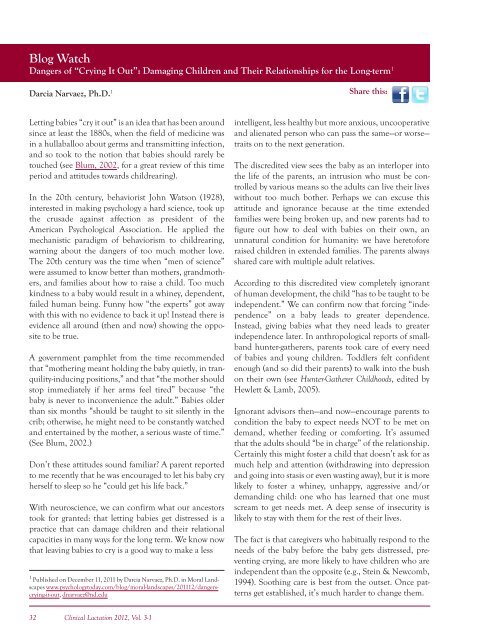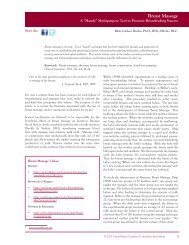Official Journal of the United States Lactation ... - Clinical Lactation
Official Journal of the United States Lactation ... - Clinical Lactation
Official Journal of the United States Lactation ... - Clinical Lactation
You also want an ePaper? Increase the reach of your titles
YUMPU automatically turns print PDFs into web optimized ePapers that Google loves.
Blog Watch<br />
Dangers <strong>of</strong> “Crying It Out”: Damaging Children and Their Relationships for <strong>the</strong> Long-term 1<br />
Darcia Narvaez, Ph.D. 1<br />
Share this:<br />
Letting babies “cry it out” is an idea that has been around<br />
since at least <strong>the</strong> 1880s, when <strong>the</strong> field <strong>of</strong> medicine was<br />
in a hullaballoo about germs and transmitting infection,<br />
and so took to <strong>the</strong> notion that babies should rarely be<br />
touched (see Blum, 2002, for a great review <strong>of</strong> this time<br />
period and attitudes towards childrearing).<br />
In <strong>the</strong> 20th century, behaviorist John Watson (1928),<br />
interested in making psychology a hard science, took up<br />
<strong>the</strong> crusade against affection as president <strong>of</strong> <strong>the</strong><br />
American Psychological Association. He applied <strong>the</strong><br />
mechanistic paradigm <strong>of</strong> behaviorism to childrearing,<br />
warning about <strong>the</strong> dangers <strong>of</strong> too much mo<strong>the</strong>r love.<br />
The 20th century was <strong>the</strong> time when “men <strong>of</strong> science”<br />
were assumed to know better than mo<strong>the</strong>rs, grandmo<strong>the</strong>rs,<br />
and families about how to raise a child. Too much<br />
kindness to a baby would result in a whiney, dependent,<br />
failed human being. Funny how “<strong>the</strong> experts” got away<br />
with this with no evidence to back it up! Instead <strong>the</strong>re is<br />
evidence all around (<strong>the</strong>n and now) showing <strong>the</strong> opposite<br />
to be true.<br />
A government pamphlet from <strong>the</strong> time recommended<br />
that “mo<strong>the</strong>ring meant holding <strong>the</strong> baby quietly, in tranquility-inducing<br />
positions,” and that “<strong>the</strong> mo<strong>the</strong>r should<br />
stop immediately if her arms feel tired” because “<strong>the</strong><br />
baby is never to inconvenience <strong>the</strong> adult.” Babies older<br />
than six months “should be taught to sit silently in <strong>the</strong><br />
crib; o<strong>the</strong>rwise, he might need to be constantly watched<br />
and entertained by <strong>the</strong> mo<strong>the</strong>r, a serious waste <strong>of</strong> time.”<br />
(See Blum, 2002.)<br />
Don’t <strong>the</strong>se attitudes sound familiar A parent reported<br />
to me recently that he was encouraged to let his baby cry<br />
herself to sleep so he “could get his life back.”<br />
With neuroscience, we can confirm what our ancestors<br />
took for granted: that letting babies get distressed is a<br />
practice that can damage children and <strong>the</strong>ir relational<br />
capacities in many ways for <strong>the</strong> long term. We know now<br />
that leaving babies to cry is a good way to make a less<br />
1 Published on December 11, 2011 by Darcia Narvaez, Ph.D. in Moral Landscapes<br />
www.psychologytoday.com/blog/moral-landscapes/201112/dangerscrying-it-out,<br />
dnarvaez@nd.edu<br />
intelligent, less healthy but more anxious, uncooperative<br />
and alienated person who can pass <strong>the</strong> same—or worse—<br />
traits on to <strong>the</strong> next generation.<br />
The discredited view sees <strong>the</strong> baby as an interloper into<br />
<strong>the</strong> life <strong>of</strong> <strong>the</strong> parents, an intrusion who must be controlled<br />
by various means so <strong>the</strong> adults can live <strong>the</strong>ir lives<br />
without too much bo<strong>the</strong>r. Perhaps we can excuse this<br />
attitude and ignorance because at <strong>the</strong> time extended<br />
families were being broken up, and new parents had to<br />
figure out how to deal with babies on <strong>the</strong>ir own, an<br />
unnatural condition for humanity: we have heret<strong>of</strong>ore<br />
raised children in extended families. The parents always<br />
shared care with multiple adult relatives.<br />
According to this discredited view completely ignorant<br />
<strong>of</strong> human development, <strong>the</strong> child “has to be taught to be<br />
independent.” We can confirm now that forcing “independence”<br />
on a baby leads to greater dependence.<br />
Instead, giving babies what <strong>the</strong>y need leads to greater<br />
independence later. In anthropological reports <strong>of</strong> smallband<br />
hunter-ga<strong>the</strong>rers, parents took care <strong>of</strong> every need<br />
<strong>of</strong> babies and young children. Toddlers felt confident<br />
enough (and so did <strong>the</strong>ir parents) to walk into <strong>the</strong> bush<br />
on <strong>the</strong>ir own (see Hunter-Ga<strong>the</strong>rer Childhoods, edited by<br />
Hewlett & Lamb, 2005).<br />
Ignorant advisors <strong>the</strong>n—and now—encourage parents to<br />
condition <strong>the</strong> baby to expect needs NOT to be met on<br />
demand, whe<strong>the</strong>r feeding or comforting. It’s assumed<br />
that <strong>the</strong> adults should “be in charge” <strong>of</strong> <strong>the</strong> relationship.<br />
Certainly this might foster a child that doesn’t ask for as<br />
much help and attention (withdrawing into depression<br />
and going into stasis or even wasting away), but it is more<br />
likely to foster a whiney, unhappy, aggressive and/or<br />
demanding child: one who has learned that one must<br />
scream to get needs met. A deep sense <strong>of</strong> insecurity is<br />
likely to stay with <strong>the</strong>m for <strong>the</strong> rest <strong>of</strong> <strong>the</strong>ir lives.<br />
The fact is that caregivers who habitually respond to <strong>the</strong><br />
needs <strong>of</strong> <strong>the</strong> baby before <strong>the</strong> baby gets distressed, preventing<br />
crying, are more likely to have children who are<br />
independent than <strong>the</strong> opposite (e.g., Stein & Newcomb,<br />
1994). Soothing care is best from <strong>the</strong> outset. Once patterns<br />
get established, it’s much harder to change <strong>the</strong>m.<br />
32 <strong>Clinical</strong> <strong>Lactation</strong> 2012, Vol. 3-1




